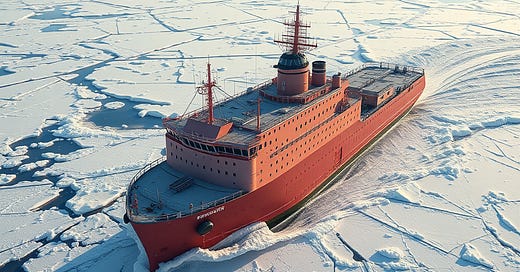Is Canada About to Lose Its Arctic?
Sovereignty over Canada’s Arctic is now up for grabs, with China among the contenders.
By Patricia Adams and Lawrence Solomon | The Adams-Solomon Report
Almost two decades ago, Canada recognized that its claim to the Arctic was on thin ice.
“Canada has a choice when it comes to defending our sovereignty over the Arctic,” Prime Minister Stephen Harper announced in 2007 at Canada’s Pacific Fleet in Esquimalt, B.C. “We either use it or lose it. And make no mistake, this government intends to use it.”
To put Canada’s claim to the Arctic on solid footing, the government announced the construction of a deep-water port in the far North to house an armed fleet of Polar Class (PC) 5 Arctic Offshore Patrol Ships, capable of operating in ice up to one meter thick. By engaging in full operations on the Arctic East and West Coasts throughout the year, Canada would be able to assert a credible claim.
“In defending our nation’s sovereignty, nothing is as fundamental as protecting Canada’s territorial integrity; our borders, our airspace and our waters,” Harper stressed.
Harper’s grand plans—including other deep-sea ports and year-round roads to link Arctic ports with the Canadian south—never came to fruition. Canada still has no deepwater Arctic port. Rather than an Arctic flotilla engaging in full operations on both coasts, the most Canada usually musters to signify its sovereignty in the high Arctic are abbreviated summertime visits. By that measure, Viking Cruises, which typically operates three or four Arctic voyages per year, has a comparable claim to the Arctic.
Harper was astute in recognizing the forces that would be descending on Canada’s Arctic. Foremost of those at the time was Russia, which has had by far the largest presence in the Arctic and, in 2007, planted a flag on the seabed at the North Pole in preparation to claiming 460,000 square miles of underwater territory. The U.S., which hasn’t recognized Canada’s sovereignty over the Northwest Passage, has also been a rival.
Today the claimants to the Arctic are ever more active. With a United States Geological Survey estimating that the north may contain 22 percent of the world’s undiscovered resources. With global warming expected to make Arctic resources exploitable, claims to the Arctic are mounting.
Russia is displaying its dominance with three dozen icebreakers, including four nuclear-powered icebreakers and a nuclear-powered cargo ship, giving it by far the world’s largest Arctic fleet. China has also emerged as a formidable entrant into the region by asserting an entitlement to Arctic resources through a claim of being “a near-Arctic state.” China already has three icebreakers plying Arctic waters with more on the way, including a nuclear-powered icebreaker expected this year. To surpass the rival fleets of both Russia and China, U.S. President Trump declared that he intends to build “40 big icebreakers.”
Canada, in comparison, has but two aging icebreakers near the end of their service life and has only recently ordered two new ones, to be completed by 2030. If past experience is a predictor of future performance, however, those icebreakers won’t materialize—most of Canada’s Arctic initiatives lie moribund due to lack of funding.
Canada’s abject Arctic record was documented in a 2022 report by Canada’s Auditor General, who reported that “long-standing issues include incomplete surveillance, insufficient data about vessel traffic in Canada’s Arctic waters, poor means of sharing information on maritime traffic, and outdated equipment. The renewal of vessels, aircraft, satellites, and infrastructure that support monitoring maritime traffic and responding to safety and security incidents has fallen behind to the point where some will likely cease to operate before they can be replaced.”
The Inuit have also become formidable players. The Inuit Circumpolar Council, which represents some 180,000 Inuit in Alaska, Canada, Greenland, and Russia, formally aspires to sovereignty. Once it determines that the time is ripe to declare sovereignty, potentially with backing by China and the UN, Canada would have no ability to militarily prevent them from obtaining a foothold in its Arctic territory. Not that Trump would permit Canada’s north to fall into the hands of a group allied with China. To prevent it, Trump might decide to seize Canada’s northern territories, as he intends to seize neighboring Greenland.
The Circumpolar Inuit Declaration on Sovereignty in the Arctic correctly notes that “Sovereignty is a contested concept, however, and does not have a fixed meaning.”
Canada’s strongest claim to sovereignty among the many different legal opinions as to what constitutes sovereignty is generally thought to rest on the United Nations Convention on the Law of the Sea (UNCLOS), to which Canada is a party. UNCLOS provides Canada with little solace, however. The United States is not a party to UNCLOS; Russia, which is a party, states it is considering leaving UNCLOS, and China, also a party, flagrantly disregards UNCLOS rulings with which it disagrees.
Ultimately, the only law throughout history that determined sovereignty has been “might makes right.” On that criterion, Canada falls woefully, hopelessly short.
With Russia, China, the U.S. and the Inuit all circling to establish or strengthen claims to sovereignty over Arctic resources, a future conflict appears inevitable. Canada’s Arctic is now up for grabs, with Canada all-but-certain to emerge a loser.
First published by The Adams-Solomon Report.
Patricia Adams is an economist and executive director of Probe International.
Lawrence Solomon is a columnist for the National Post and Epoch Times, and a past columnist for the Globe and Mail. The Deniers, a #1 environmental best seller on global warming, was deemed one of the “10 Books That Drive The Debate” by the US National Chamber of Commerce. He can be reached at LS@lawrencesolomon.ca.
Image created by Generative AI.



